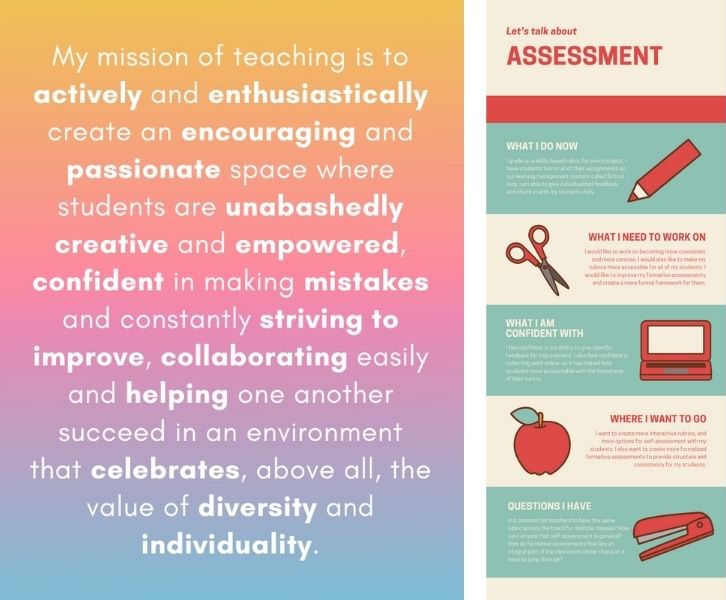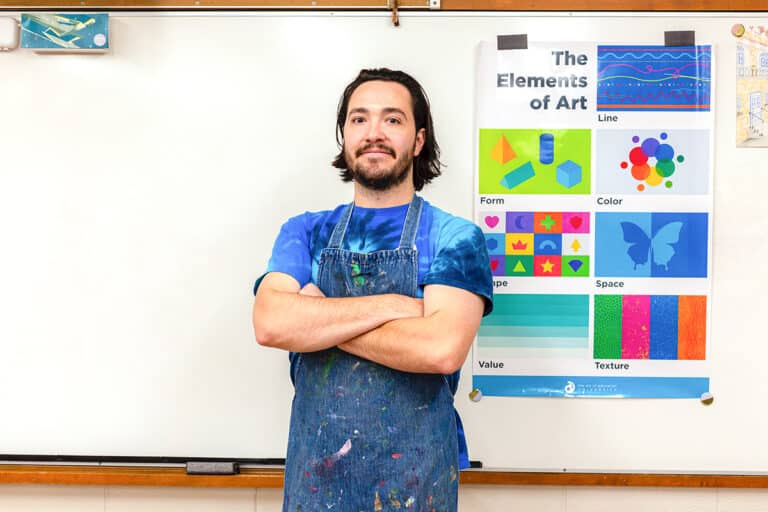Are you intrigued about the courses offered by The Art of Education University? Have you clicked through to read about the Master’s program but want to hear what the student experience is like before you commit? My name is Jennie Drummond, and I was in the first graduating class of the AOEU Masters in Arts Education program. I’m excited to share four things that made pursuing my Master’s with AOEU a positive experience.

How did I land on AOEU?
When I started the program, I was 27 years old, living in California’s Bay Area. I had taught art for six and a half years at a public high school. I am also a practicing artist, yearbook advisor, dog mom, and devoted aunt. I was hesitant to get my Master’s because it seemed like no one felt comfortable teaching art teachers. Then, AOEU announced they were starting a Master’s program! I was already an avid user of their PRO Packs, so I knew AOEU provided relevant, quality, and diverse learning. I applied, and I am so glad I did. Because of what I gained from the AOEU Master’s program, I have become a better teacher and a more disciplined artist.
Read on for four things that made pursuing my Master’s degree with AOEU a win!

1. The program is entirely online.
While all the courses are virtual, they have a relevant curriculum, engaging discussion board conversations, and absorbing projects. I was nervous about an all-online program, especially when it came to studio courses. How would it all work? The first studio course I took was Studio: Fibers. To my surprise, the course material hooked me, and I felt very included, which was something I was not expecting from an online course.
2. The work is immediately applicable.
Every single project, written assignment, or art piece I created in an AOEU course was immediately applicable to my work as an art teacher. The studio classes provide a place to lesson plan and experiment with new techniques. During my Studio: Fibers course, I was inspired to bring fibers into my art room. While I had never taught fibers before, the course material helped me feel so prepared that I was ready to jump in! It stretched my curriculum and my comfort level and exposed my students to more hands-on forms of artmaking.

This also applies to core classes, such as Managing the Art Room. While you don’t make as much art in core classes, you still create resources you can use in your classroom right away. For example, I composed a mission of teaching and reflected on my assessment practices. Through this ridiculously relevant curriculum, I felt more invested in bettering myself as a teacher. I also felt more invested in the AOEU program because I felt that my time was being valued rather than spent on busywork.

In all of my core courses, the work was broken down into manageable chunks. This “chunking” vastly improved my productivity and engagement because the breaks were built into the curriculum itself. There were also plenty of opportunities for personal choice. I was able to focus on articles and resources that I knew applied directly to my classroom environment and expectations. All of this helped me interact productively with the content and curriculum provided.
3. Flexibility and designated time to create are prioritized.
Flexibility is built into the master’s program. This means that you can pursue multiple studio courses in a variety of media and disciplines. I gravitated toward the studio courses because they pushed me to carve out time to make art.

Because of how the scope and sequence for the studio courses are designed, you can easily build lessons to share with your students as you make your way through the course. As you create the art projects required for the course, you also create an example to share with your students. I was able to create many materials that I have since shared with my students to supplement their learning.
The studio courses also build in critiques. Getting feedback from fellow art teachers who are talented and committed art educators was as helpful as it was inspiring.
4. The faculty has art classroom experience and are incredibly supportive.
I found that the faculty were the biggest help in balancing all of the moving parts of being an active art teacher and full-time graduate student. Since AOEU faculty are currently involved in art education, everyone was understanding and patient with one another. Many are also in the K–12 art room during the day! This environment provided me with support that was specific and empathetic to the challenges I faced. I even maintained contact with a couple of faculty members since graduating.

Whether you want to take one course or earn a full degree, I highly recommend The Art of Education University. If you are considering diving into the AOEU Master’s program, try taking a course first so you can see what all the hype is about. Two great courses to start with are Studio: Fibers and Managing the Art Room. Talk to an Admissions Counselor to help you choose a course that can go towards your degree should you decide to keep going. I can honestly say that this program helped better me as an artist, a teacher, and a person. I hope it does the same for you too.
Are you interested in learning more about AOEU’s Master’s degree program?
- Life as an AOEU Master’s Student (Ep. 116)
- Master’s Degree Mailbag (Ep. 193)
- Exploring the AOEU Master’s Degree (Ep. 199)
What is one question you still have about being an AOEU student?
How do you prioritize furthering your own education?
Magazine articles and podcasts are opinions of professional education contributors and do not necessarily represent the position of the Art of Education University (AOEU) or its academic offerings. Contributors use terms in the way they are most often talked about in the scope of their educational experiences.





